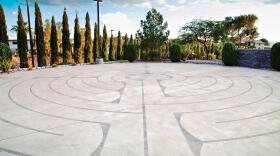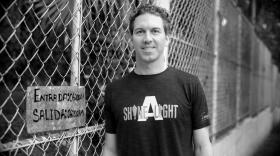Nevada is an early adopter in a new movement to prevent child sexual abuse — a public-health crisis of epidemic proportions, advocates warn
In a small, windowless room toward the back of the Rape Crisis Center were several pictures — children’s crayon drawings like those parents tack to refrigerators. But these pictures showed scenes that parents might not want to display: for instance, a stick figure girl facing down a stick figure man and spewing a fiery word bubble, “No!” They were as hard to look at as the video in the prevention section on the center’s website is to watch. Celebrity narrators explain that someone is sexually assaulted in the U.S. every two minutes, half the victims are younger than 18, and children are warned by their abusers not to tell. Then, a tiny girl with dark, round eyes looks into the camera and, in a toddler’s lisp, says, “I don’t have to keep a secret.”
Those unfamiliar with current thinking about sexual assault might not expect such images from a rape crisis center. Rape is what happens when a woman walking home alone at night is grabbed by a stranger and dragged into an abandoned alley, right? Yes — but such scenarios are only a small piece of the picture. Eight times out of 10, a rape victim knows her attacker. More than one-third of those who sexually abuse children are family members.
These and many other statistics from many other studies over the last two decades are leading to a shift in the fight against sexual assault.
Enough is enough: Counselors attend an Enough Abuse training session at the Rape Crisis Center in May.
“I was at a conference where someone likened it to being downriver and fishing someone out every few minutes,” says Daniele Dreitzer, executive director of the Rape Crisis Center, which currently responds to some 60-plus calls from the county hospital per month. “You can help them, and it may save their lives, but you also need to send someone upriver to figure out who’s throwing them in to begin with.”
“Up-river,” in this case, can mean back to childhood. If, one school of thought argues, a community could learn to talk and listen to kids stigma-free, spot red flags of assault and intervene before something happens, then it would raise generations of empowered people who are less likely to be victimized, while also disabling potential abusers. As with other public-health crises, early prevention would also have tangible benefits, such as saving the cost of treating long-term mental-health issues that can result from child sexual abuse.
The Rape Crisis Center’s collection of drawings hangs somewhere else now. Since the media tour of the facility’s then-new expansion last fall, the center has moved again, more than doubling the amount of space it had a year ago. Demand is high for services at Nevada’s only nonprofit dedicated solely to sexual violence awareness and prevention. But with help from donors, the government and a UNLV think tank, a team with a new mission is headed upstream. It’s hoping to stanch the flow of violence at its source.
*****
The issue of campus rape has gotten a lot of attention lately. Two years ago, the White House launched a related initiative called “It’s On Us,” which was followed by the Association of American Universities’ controversial study suggesting one in four female college students had been sexually assaulted. The Hunting Ground won several film awards, and Lady Gaga performed its theme song live at the Oscars, flanked by dozens of survivors.
So far, child sexual abuse hasn’t enjoyed much public awareness outside its role in the movie Spotlight. And yet, on average, more boys and girls are sexually abused than college men and women each year. The CDC estimates that some 13 million kids living in America today are sex-abuse victims. Nevada had 540 substantiated cases of child sexual maltreatment in 2013.
“If this were Ebola, the whole world would shut down. … Where are the bracelets, the ribbons, the race to cure this disease?” asked Jill Tolles, a UNR communications studies professor, in her February TEDx talk titled “Finding Courage to Talk About Child Sexual Abuse.”
Tolles was part of a state task force that Child and Family Services, following a law passed in the 2013 Legislature, appointed to study the issue. The group completed its work the following year and issued a report with several recommendations. In the 2015 Legislature, one of those recommendations became a law requiring all Nevada schools to have sexual abuse and safety education for students by 2020. Standards for the curricula are to be completed this summer.
“This was an exciting bill,” says Kristy Oriol, policy specialist for the Nevada Network Against Domestic Violence and another member of the task force. “It’s really important to reach children at a young age and teach them about boundaries, healthy relationships and resources that are available. This not only helps prevent future abuse, but also, if it’s happening, helps them find someone safe to talk to.”
The Rape Crisis Center already works with the Clark County School District through the Child Assault Prevention program, which teaches early elementary-aged children their basic rights to be safe, strong and free, and YourSpace, a safety prevention curriculum for middle- and high-school students
Experts applaud programs like these, but some believe they hit only half the necessary audience. The other half? Adults.
*****
In April, Sexual Assault Awareness Month, Vice President Joe Biden and Lady Gaga visited UNLV to promote It’s On Us. Freshman Caitlyn Caruso introduced the theme of the event through her own story of being molested by a family friend when she was 11.
“I was told I should be grateful that my assaulter chose me, since he didn’t do things with girls like me, usually,” Caruso said. “I would say it’s on us to … share our stories. But it’s not. It’s not on us as survivors. It’s on you. … We’re asking you to amplify our voices, to support us, and most importantly, to believe us. We are asking you all to be active bystanders. We’re asking you to intervene before it’s too late.”
Caruso, now a survivors’ advocate, touches on several key themes in current awareness and prevention trends. Perpetrators choose their victims carefully and groom them to stay silent, so it’s important to take shame and silence out of the equation. But for that to happen, grownups have to be comfortable with the language of a difficult subject. And they have to be attuned to risky behaviors.
That’s the idea behind Enough Abuse, a campaign that started in Massachusetts and has since been adopted in seven other states. In 2014, the Rape Crisis Center was looking for an effective prevention program. Working with UNLV-based Prevent Child Abuse Nevada, it settled on Enough Abuse. The two organizations won a $265,000 grant and launched it here.
Since then, more than 300 parents and professionals from churches, community centers, schools, sports teams, youth programs — any place that caters to children — have attended the free Enough Abuse educational seminars. They learn to look for things like adults who text excessively with kids after hours, or who frequently set up unnecessary one-on-one situations with them. They learn what’s myth (“He seemed like such a nice guy”) and what’s fact (predators often use charm to deflect attention).
Enough Abuse also has a policy component to help institutions implement rules that bolster the education staff are receiving.
“An example would be if CCSD had a policy that allowed any employee of the district to only communicate with kids through school-approved communications, like Edmodo,” Dreitzer says, “and if they’re found to do so in other ways, there are disciplinary consequences.” (CCSD did not respond to Desert Companion’s request for an interview. The school does have a mandatory reporting policy on general child abuse.)
Enough Abuse boldly states that it will reach every area in Nevada by 2018. Dreitzer believes the goal is within reach, because the program has moved into a train-the-trainer phase. Instead of relying on out-of-state experts to come give seminars, it’s now building its own stable of in-state experts. This means the number of presentations being given can increase exponentially.
In another sign of hope, state organizations that focus on various related issues have been working to form an anti-sexual violence coalition. It would provide the same kind of support — and, hopefully, funding — that’s already available for domestic-violence advocates and victims.
“What’s so nice about this work is the prevention focus,” Oriol says. “So much of what we do is important and necessary … but, of course, it we could prevent it from happening to begin with, that would be better. The goal is to put us all out of work.”










